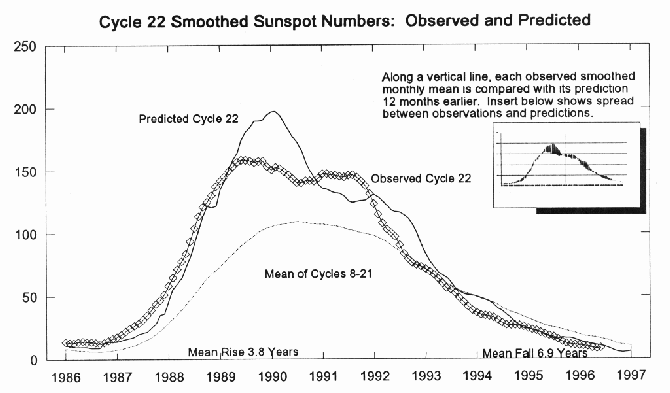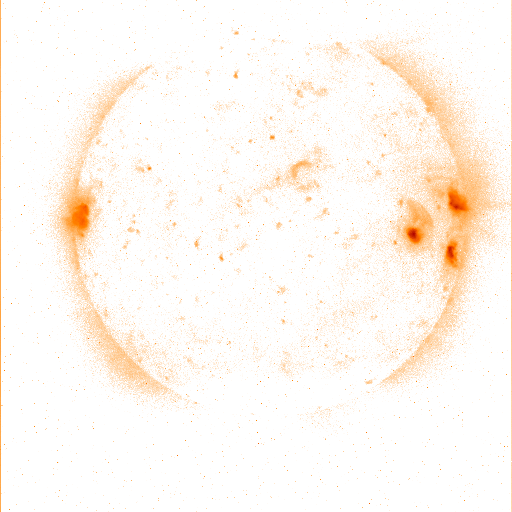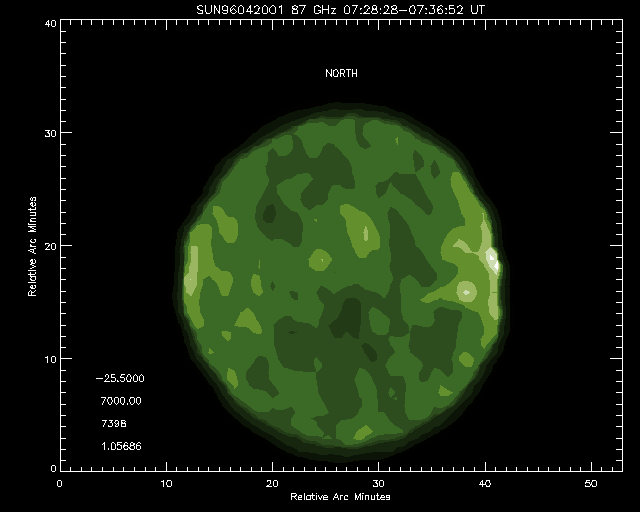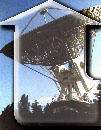Solar Research at MetsähoviText by Silja Pohjolainen
1. BackgroundRadio radiation from the Sun was first detected in 1942, at a British radar station. This radiation had been predicted earlier, but mainly due to poor sensitivity of instruments the detection had not been verified. After the Second World War solar radio astronomy was started at meter and decimeter wavelengths. With better receivers the study of solar millimeter wave radiation started around 1970. The first solar radio maps were measured at Metsähovi in 1976. After that, 20-25% of the telescope time has been used for solar research. The following wavelengths (frequencies) have been used: 25 mm (12 GHz), 13 mm (22 GHz), 8 mm (37 GHz), 4 mm (79 GHz), and 3 mm (90 GHz). Solar centimeter and millimeter wave radiation has been studied at Metsähovi in both general and detailed analyses. Selected topics over the years have included: impulsive radio bursts, gradual bursts, solar S-component, 160 min oscillation, coronal millimeter wave sources, coronal mass ejections, low temperature areas, enhanced radiation close to the poles and their connection to coronal holes, and correlation with other solar radiation phenomena. Most of the studies have been done in international cooperation, with many observatories and satellites. 1.1 High frequency radio emission from the SunPossible emission mechanisms at cm- and mm-waves are gyrosynchrotron radiation by mildly relativistic electrons, synchrotron radiation by highly relativistic electrons, and thermal bremsstrahlung by electron-ion collisions in plasma. The impulsive phase of a flare is generally thought to be due to non-thermal gyrosynchrotron emission, and thermal radiation dominates only in the post-burst increase phase. The high-frequency spectrum of radio emission tells about the energy distribution in flares. Generally optically thin thermal free-free emission has a flat flux spectrum, whereas gyrosynchrotron emission falls off with increasing frequency. The spectral turnover frequencies in solar flares often fall around 10-20 GHz, so the Metsähovi frequencies represent well the optically thin side of the spectrum. The spectral characteristics of solar flares at high radio frequencies are under debate, as some observations have suggested a rising spectrum at millimeter wavelengths. There are no high spectral resolution spectrometers above 22 GHz in the world, and therefore single frequency observations are useful in determining the spectral shapes. The Metsähovi antenna with the frequencies 37 and 85-115 GHz is very useful in this respect. 1.2 Solar soft X-ray emission and correlation with radioRadiation in the soft X-ray region ( < 10 keV) is generally thought to have thermal origin. Thermal electron distribution can result from either direct heating of the flare plasma or from collisional energy transfer from non-thermal electrons to the electrons of the ambient plasma. Soft X-ray emission has been identified with e.g., solar subflares, spikes, eruptive prominences, loop prominences, type III radio bursts, gradual rise and fall radio emission, as well as "typical" flares. The soft X-ray emission is generally thought to come from loops stretched high up in the chromosphere or corona, when the evaporating hot plasma fills the loops. A large sample of radio bursts observed at Metsähovi in 1989-1993 at 22, 37, or 90 GHz (368 flares) has been analysed. Comparison with the GOES soft X-ray data showed almost linear correlation between the soft X-ray fluxes and the gradual rise and fall-type radio burst fluxes. However, no common denominator could be found for those radio bursts that lacked a counterpart in soft X-rays. Thermal bremsstrahlung component was also calculated for 8-mm bursts, using the GOES soft X-ray data. The calculated values showed good correlation with the observed fluxes in gradual rise and fall-type bursts, and in the majority of impulsive type bursts a bremsstrahlung component was found to be present. Some bursts without a thermal component were found and could be connected with high-energy electrons producing hard X-ray radiation and gyrosynchrotron emission in microwaves. 1.3 Solar hard X-ray emission and correlation with radioHard X-rays in solar flares are thought to be thick-target bremsstrahlung by high-energy electrons (> 25 keV). A non-thermal nature of hard X-rays has been accepted mainly because the energy spectra generally follow a power law, and because of the timing coincidence with impulsive microwave and other type of flares that are known to have mostly non-thermal origin. Also non-thermal burst radiation is known to be polarized, while thermal emission shows practically no polarization. Hard X-ray burst profiles are known to correlate well with cm-wave emission although the fluxes do not show correlation. Some of the Metsähovi radio bursts that were first analysed in connection with the GOES soft X-rays were also recorded at hard X-rays with CGRO-BATSE. A clear difference was found in the hard X-ray signatures of impulsive and gradual microwave bursts (Pohjolainen, Valtaoja and Urpo, 1996b). The sample was however very small and further study will be needed to confirm a statistical correlation, especially at mm-waves. 2 New instrumentation for correlation measurementsThe new polarization receiver at 37 GHz (8 mm), designed and built at Metsähovi and ready for use by the end of 1997, will give us information on the degree of circular polarization in solar active regions and flares, and the thermal/non-thermal nature of the emitting electrons at high frequencies. There are presently four satellites that can be used to correlate solar features seen in radio to features at other wavelengths: The Japanese Yohkoh satellite (launched in August 1991) carries a soft X-ray telescope (SXT), a hard X-ray telescope (HXT), as well as a spectrometer (BCS). The ESA/NASA SOHO satellite (launched in December 1995) gives information in the EUV-range, with two of it's spectrometers. Almost continuous whole-Sun soft X-ray flux data at 0.5-4 Angstrom (3-25 keV) and 1-8 Angstrom (1.5-12 keV) wavelength bands are supplied by the GOES satellites, operated by NGDC-NOAA at Boulder. The BATSE instrument onboard the Compton Gamma-Ray Observatory (CGRO) has operated since April 1991, observing galactic gamma-ray sources in all parts of the sky, at energy ranges from 25 keV to 2 MeV. The recorded solar events are available at the BATSE Solar Database. Furthermore, the Yohkoh SXT and HXT, the SOHO EIT, and the Metsähovi mapping facility at mm-waves, are all capable of full solar disk imaging. Some interesting solar flares with cm-wave (microwave) data from Metsähovi, spectral radio data from Bern and Tremsdorf, soft X-ray data from the GOES satellites, and hard X-ray data from CGRO-BATSE, have been analysed by the Metsähovi group together with colleagues in Bern and Tremsdorf. New observations are done annually, for 60-70 days each, using the receivers at 37 GHz (8 mm) and 90 GHz (3 mm). The new 37 GHz polarization receiver will be completed in 1997 and used in the upcoming years. Daily observations typically consist of measuring full Sun maps and tracking selected active regions in order to detect radiation outbursts. Metsähovi is participating in international observing campaigns, with other ground-based observatories and satellites. Analysis of the Metsähovi radio data, other wavelength ground-based data, and satellite data is done with new improved software, using integrated Solarsoft written in IDL. 3 Outburst observationsSolar activity has already reached it's minimum and is presently
growing, see the number of sunspots in Figure 1. A usual growth time is
around three years, and during this period the number of sunspots and
active regions grows rapidly. The period is very useful for studies of
active region development and configuration, and coronal source studies,
as the general level of activity is not yet disturbingly high and
different active regions can be identified without doubt. We plan to make
several long solar observing runs at Metsähovi at millimeter
wavelengths during the upcoming growth period.  Figure 1. Cycle 22 smoothed sunspot numbers: Observed and predicted (Solar Geophysical Data prompt reports, February 1997) Several active regions and coronal mass ejections have already been
observed in 1996-97. An example is presented in Figure 2, where complex
activity is present near the solar west limb in the Yohkoh soft X-ray
image. The Metsähovi 3-mm radio map observed on the same morning and
processed with the new software, Figure 3, gives positions of the
corresponding radio sources in the upper chromosphere and corona.  Figure 2. Yohkoh soft X-ray image of the Sun observed on April 20, 1996, at 8:53 UT (From the Yohkoh Website at Mullard)  Figure 3. Metsähovi 3 mm (90 GHz) solar map measured on April 20, 1996, at 7:28-7:36 UT, plotted with the new satellite data compatible software. Note the group of active regions near the solar west limb that correspond well with the regions seen at soft X-rays. The small enhancement at 3 mm near the south pole is located inside a coronal hole 4 Differential rotation and solar dynamosThe whole sample of the Metsähovi radio data from 1989-1993 was used for searching periodicity (active longitudes) in major solar flares. Two significant periodicities, 22.07 and 27.72 days, were found and interpreted as a signature of a long-lived non-axisymmetric component of the solar magnetic field below the visible surface. This project has been done in cooperation with Nordita, Denmark, and the University of Oulu, and is planned to be continued with new observational data. A study in cooperation with Tuorla Observatory has been started to
investigate solar differential rotation at high solar latitudes.
Metsähovi solar maps have revealed regions of enhanced mm-wave
radiation, close to the poles of the Sun. These features can be used as
tracers in determining the differential rotation. The connection of these
'bright point sources' at radio and other solar phenomena is still an
open question. We have found some evidence of their connection to polar
faculae, and this subject will be studied further.
|
